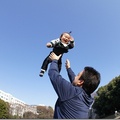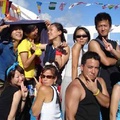私はいま27歳。自分のことを「青年」と呼ぶのはちょっと恥ずかしいのですが、「コミュニケーション時代に生まれた人」という呼称がピンと来ます。
携帯電話がレンガ級の大きさから1cm以下の「ミニパソコン」になっていくのを見てきました。家から繋ぐインターネットの速度が、56kbps(1 秒に56キロバイト)から100mbps(1秒に100メガバイト)に加速することもまた、嬉しく楽しい気持ちで見てきました。今思えば、インターネット速度って1800倍もこの数年の間に速くなったのですね。10年前には、インターネットを通して映画が見られるなんて、一般の人はだれも予測していなかっ たでしょう。
90年代半ばから2000年まで、インターネットでは、メールを送ることや写真や音楽などをダウンロードすることしかできませんでした。しかし、インターネット速度や技術が発展していくにつれ、少しずつそれが変わってきました。
近頃、インターネットは一方的に情報を貰うだけではなく、自分から情報をアップロードして表現する時代になりました。そのほかにも「ネットワーキン グ」というのも流行りだし、ミクシー、Myspace, Facebook, Orkut, Hi5, などが爆発的な利用者数を登録させるまでになりました。
ここまでで、インターネットについての説明は終わらせようと思います。私がみなさんに一番伝えたいのは、ちょっと昔の日系人と現代の日系青年のコミュニケーションの変化です。
今年はちょうど日本ブラジル交流年として、日本とブラジルの交流100周年を祝う節目の年です。横浜JICAセンターの展示会「新世界へ渡った日本人」を見る機会がありました。この展示会では、移住したばかりの日本人たちがどうやって悪戦苦闘を乗り越えていったのかがよ~く伺えます。
私が思うには、日本人特有の団体意識がそういった苦難を乗り越える強い力になったと思います。みんなで団結し、県人会、敬老会、日系人協会などをつくって、お互いを守っていったのを見習わなきゃならないなと感心しました。
この団体意識は新しい世代が生まれるにつれて薄れていったと思われがちですが、現代は家にいながらにして人と「会う」ことができるので、人とのつながりそのものが肉眼では見えにくくなっているのかもしれません。
時代が変わっても、人とコミュニケーションを取りたいという気持ちは変わらないと思います。変わったのはそのコミュニケーション方法なのではないでしょうか。
私が使っているインターネット上のページを二つ紹介したいと思います。ひとつは個人ブログ(http://blog.canpan.info/akira)、そうしてもうひとつはMixiというものです。
ブログ
留学の経験や日系人から見た日本社会を人に読ませるため、ほかの日系留学生とともに3年前からCanpan Blogというのを始めました。ブログを書くことで、私が書いているものに興味を持ち、連絡をしてくれる人たちが現れます。そのおかげで、遠い親戚に見つ けてもらったり、同じような考え方、あるいはそうでない方ともいろんな会話ができました。そのほかにも、Googleに私の名前(打村明)を検索するだけ でブログにたどり着けるのです。
Mixi.jp
ミクシーというのはソーシャル・ネットワーク・サービス(略してSNS)のウェブページで、同じような趣味や考え、出身地の人たちがインターネット上で集まれるものです。自分のブログ、趣味、考えなどをプロフィールにつけることで昔の友達と連絡を取れたり、新しい友達も作れるのです。 メインページには友達の書いた、最新のコメントやブログ記事、イベントなどが表記されるので何が起きているのかが一目で分かります。現代の日系青年のミクシーは数十年前の日系移住者たちのペルー新報や日系新聞と同じ役割を果たしているのではないでしょうか。
私は日本に住む日系青年やHapaのミクシーコミュニティに参加しているのですが、そこでは掲示板のテーマ(たとえば「日系人とは」、「現代の青 年日系」など)に書き込んだり、東京のどこかで開催される「オフ会」という宴会に2ヶ月に1回参加したりします。オフラインで行われる宴会なので、オフ会。
結局、なにを言いたいかというと、人は自分と似た経験や趣味、出身地などの人とコミュニケーションを取りたがるのは今も昔も変わらないということ。 そしてインターネット世代に生きる私たちが、今、頭を悩ませているのは、画期的なコミュニケーションツールを使って、「何をするのか」と「どういうふうに するのか」ということですね。
© 2008 Akira Uchimura






